- Home
- About
- Map
- Trips
- Bringing Boat West
- Migration West
- Solo Motorcycle Ride
- Final Family XC Trip
- Colorado Rockies
- Graduates' XC Trip
- Yosemite & Nevada
- Colorado & Utah
- Best of Utah
- Southern Loop
- Pacific Northwest
- Northern Loop
- Los Angeles to NYC
- East Coast Trips
- Martha's Vineyard
- 1 Week in Quebec
- Southeast Coast
- NH Backpacking
- Martha's Vineyard
- Canadian Maritimes
- Ocracoke Island
- Edisto Island
- First Landing '02
- Hunting Island '02
- Stowe in Winter
- Hunting Island '01
- Lake Placid
- Chesapeake
- Provincetown
- Hunting Island '00
- Acadia in Winter
- Boston Suburbs
- Niagara Falls
- First Landing '99
- Cape Hatteras
- West Coast Trips
- Burning Man
- Utah Off-Roading
- Maui
- Mojave 4WD Course
- Colorado River Rafting
- Bishop & Death Valley
- Kauai
- Yosemite Fall
- Utah Off-Road
- Lost Coast
- Yosemite Valley
- Arizona and New Mexico
- Pescadero & Capitola
- Bishop & Death Valley
- San Diego, Anza Borrego, Joshua Tree
- Carmel
- Death Valley in Fall
- Yosemite in the Fall
- Pacific Northwest
- Utah Off-Roading
- Southern CA Deserts
- Yosemite & Covid
- Lake Powell Covid
- Eastern Sierra & Covid
- Bishop & Death Valley
- Central & SE Oregon
- Mojave Road
- Eastern Sierra
- Trinity Alps
- Tuolumne Meadows
- Lake Powell Boating
- Eastern Sierra
- Yosemite Winter
- Hawaii
- 4WD Eastern Sierra
- 4WD Death Valley +
- Southern CA Deserts
- Christmas in Tahoe
- Yosemite & Pinnacles
- Totality
- Yosemite & Sierra
- Yosemite Christmas
- Yosemite, San Diego
- Yosemite & North CA
- Seattle to Sierra
- Southwest Deserts
- Yosemite & Sierra
- Pacific Northwest
- Yosemite & South CA
- Pacific Northwest
- Northern California
- Southern Alaska
- Vancouver Island
- International Trips
- Index
- Tips
- Books
- Photos/Videos
- Search
- Contact
Mammoth Lakes, CA
Tuesday, October 9, 2018 - 10:00pm by Lolo
55 miles and 1.25 hours from our last stop - 2 night stay
Travelogue
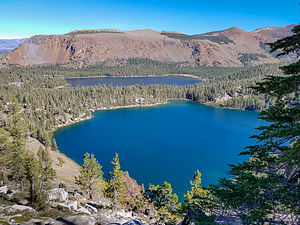 Lake George and Lake MaryWe decided to move our operation south 50 miles or so down 395 to the town of Mammoth Lakes for more hiking, fishing, and hopefully even some natural hot springing. Plus, Hilda really had her heart set on seeing Devils Postpile, a unique 60-foot cliff of symmetrical, hexagonal, basalt columns formed over 80,000 years ago. Herb and I had been there in 2014, but were more than happy to visit it again so Hilda could get a chance to see this natural wonder.
Lake George and Lake MaryWe decided to move our operation south 50 miles or so down 395 to the town of Mammoth Lakes for more hiking, fishing, and hopefully even some natural hot springing. Plus, Hilda really had her heart set on seeing Devils Postpile, a unique 60-foot cliff of symmetrical, hexagonal, basalt columns formed over 80,000 years ago. Herb and I had been there in 2014, but were more than happy to visit it again so Hilda could get a chance to see this natural wonder.
Herb and I had left before Hilda and Paul, so we decided to stop at the US Forest Service Ranger Station in Mammoth Lakes to get information on hikes. When we asked about whether we could drive to Devils Postpile rather than take the shuttle which is mandatory during the peak season, we were told that the gates to Devils Postpile were closing at noon that very day, for the rest of the season, so that road maintenance could be done. I can’t believe we missed it by a day.
 Arrival at Crystal LakeHowever, we did get some useful information. There was a Forest Service campground right behind the ranger station that accommodated large RVs. Herb still wanted to stay at the Mammoth Mountain RV Park across the road, because he wanted to have electricity so he could run the portable heater all night. Despite his years of winter camping in a tent, for the last 10 years or so he no longer likes the cold and will gladly give up scenery (at times) for the creature comforts our Polonis heater provides.
Arrival at Crystal LakeHowever, we did get some useful information. There was a Forest Service campground right behind the ranger station that accommodated large RVs. Herb still wanted to stay at the Mammoth Mountain RV Park across the road, because he wanted to have electricity so he could run the portable heater all night. Despite his years of winter camping in a tent, for the last 10 years or so he no longer likes the cold and will gladly give up scenery (at times) for the creature comforts our Polonis heater provides.
After breaking the bad news about Devils Postpile to Hilda, and watching her go through the five stages of grieving, we set up camp before setting out on a hike. We went to the commercial campground, but they chose Shady Rest, the more pristine and private forest campground. They were less than a quarter of a mile apart.
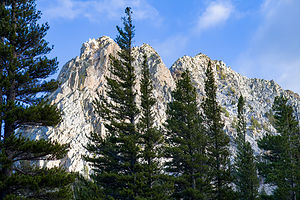 Hike to Crystal LakeOnce settled in to our respective campsites, we hopped in our Subaru (tow vehicle), picked up Hilda and Paul at their campsite, and headed to the Crystal Lake trailhead, near the Woods Lodge cabins on Lake George, about 5 miles from the center of town.
Hike to Crystal LakeOnce settled in to our respective campsites, we hopped in our Subaru (tow vehicle), picked up Hilda and Paul at their campsite, and headed to the Crystal Lake trailhead, near the Woods Lodge cabins on Lake George, about 5 miles from the center of town.
Like our hike the previous day, this one also had a lot of incredible scenery packed into a 4-mile out-and-back hike.
For the first mile and a half, the trail climbed pretty steadily, but there were plenty of views of the Mammoth Lakes Basin to distract us. At the one mile point, there was a gorgeous view of Lake Mary and Lake George behind us.
From there we continued up a series of switchbacks before beginning a slight descent down to the shores of Crystal Lake, tucked in a hollow below 10,377-foot Crystal Crag. It was a little confusing at first as to how best to get access to the lake. There are some use trails that travel part way back the steep-sloped western shore, but we took the more gently sloping paths on the east side of the lake.
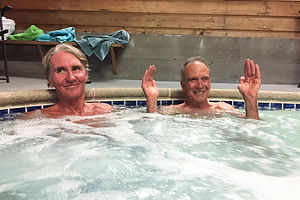 Fish TalesHilda and I settled on a comfy rock, while the guys got out the rods they had been carrying in their packs and tried their luck again to see if there were any interested trout. After a bit, we heard Paul yell that he got one, so Hilda and I ran towards his voice, hoping to get a picture of his fish, as we had missed getting to him in time the day before. Running uphill at that altitude was definitely felt.
Fish TalesHilda and I settled on a comfy rock, while the guys got out the rods they had been carrying in their packs and tried their luck again to see if there were any interested trout. After a bit, we heard Paul yell that he got one, so Hilda and I ran towards his voice, hoping to get a picture of his fish, as we had missed getting to him in time the day before. Running uphill at that altitude was definitely felt.
Still we did not get to him before he had thrown in back, but fortunately he took a picture of his prize with his iPhone. It was a beaut, and one which we couldn’t definitively identify. The debate became Cutthroat or Wild Golden trout. Paul posted a picture of it on the Eastern Sierra Fly Fishing Facebook Forum, and within minutes, he got dozens of responses from various fishermen stating their point of view. Men certainly do love talking about fishing - probably as much as they enjoy the act itself.
 Hot CreekWhile this was going on, the weather was changing significantly - the wind picked up and clouds had pretty much obscured the sunshine that had been keeping us warm. What a difference. On went our down jackets, hats, and gloves for the hike back. We were quite cold by the time we got back to the car.
Hot CreekWhile this was going on, the weather was changing significantly - the wind picked up and clouds had pretty much obscured the sunshine that had been keeping us warm. What a difference. On went our down jackets, hats, and gloves for the hike back. We were quite cold by the time we got back to the car.
Back in town we grabbed a cup of coffee and some cookies at the Erick Schat’s bakery to warm up before heading over to the Mammoth Brewing Company for a well-deserved beer and a bite to eat. The food was pretty much just okay, but the views from the large windows and the beers made up for it.
Paul continued to monitor the Cutthroat vs. Golden debate on his phone and by the end of our meal announced Wild Golden trout as the winner. There were almost a hundred fishermen weighing in on the debate.
 Outlaws hit the Upper Owens RiverThe next day we decided to explore the Upper Owens River, another one of the Eastern Sierra’s acclaimed fishing spots, which oxbows its way through a beautiful meadow in the Long Valley Caldera. Herb and I had been to the area before, not to fish, but to soak in it one of its many lovely hot springs.
Outlaws hit the Upper Owens RiverThe next day we decided to explore the Upper Owens River, another one of the Eastern Sierra’s acclaimed fishing spots, which oxbows its way through a beautiful meadow in the Long Valley Caldera. Herb and I had been to the area before, not to fish, but to soak in it one of its many lovely hot springs.
Our Subaru, which we tow behind the motorhome, was the perfect vehicle for exploring the dirt roads through the Long Valley, so we picked up Hilda and Paul and headed south on 395 for about 3 miles before turning left onto Hot Creek Hatchery Road, which runs alongside the Owens River.
In about 3 miles we stopped at the Hot Creek Geothermal Area, which used to be a popular soaking spot, but has been closed and fenced off for some time because the water temperature has risen to a point that would scald anyone who entered. However, it is still an interesting and pretty place to visit.
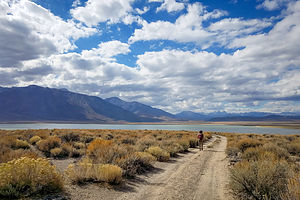 Hike to Crowley Lake ColumnsWe walked down a paved path along a fenced walkway, overlooking two beautiful aquamarine hot springs feeding into a winding cold-water creek. It is the cold water creek upstream from the hot spot that is known to have good fishing, but alas, someone had beaten us to the spot and didn’t look like he wanted us to join him.
Hike to Crowley Lake ColumnsWe walked down a paved path along a fenced walkway, overlooking two beautiful aquamarine hot springs feeding into a winding cold-water creek. It is the cold water creek upstream from the hot spot that is known to have good fishing, but alas, someone had beaten us to the spot and didn’t look like he wanted us to join him.
So, we continued along the dirt road that traced the river, with Paul getting out every once in a while to feel the temperature of the river, in the aim of selecting a spot where the water was cool enough for any self-respecting trout to enjoy. Finally we found a spot that was deemed to be “just right” and settled in - Hilda and I in our Crazy Creeks and Paul and Herb with their rods.
Since the Owens River runs through an open meadow, there is not much shrubbery along its banks, which is great in terms of not getting a lure stuck in a bush, but bad in that the trout can see you coming. For the spectators the view of the surrounding mountains was great and watching our husbands sneaking up on fish and trying to outsmart them was quite entertaining.
 Hilda spots the ColumnsAlthough there were several nibbles, no fish was landed, so after about an hour we ate our lunch and decided to set out on a quest to find the mysterious stone columns of Crowley Lake, which Herb had discovered on a website called Atlas Obscura, which has a database of interesting hidden places and scientific marvels around the world. It’s really worth checking out.
Hilda spots the ColumnsAlthough there were several nibbles, no fish was landed, so after about an hour we ate our lunch and decided to set out on a quest to find the mysterious stone columns of Crowley Lake, which Herb had discovered on a website called Atlas Obscura, which has a database of interesting hidden places and scientific marvels around the world. It’s really worth checking out.
We entered Crowley Lake Stone Columns in as a destination on Google Maps and sure enough it came up with directions to the Crowley Lake Stone Columns parking lot, 22 miles away, some of which was on paved road and some on dirt. The Subaru was a pretty capable 4WD vehicle, so we decided to try it.
Everything was going famously until the last 2 miles, when we came upon an extremely steep uphill, with giant gullies in it. We walked up and down it, but just didn’t feel comfortable trying it. Besides, we were hikers, and Google Maps said we were just 1.7 miles away.
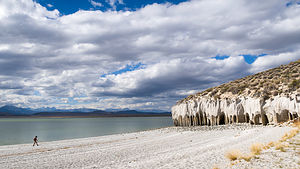 Lolo approaches the ColumnsSo, we parked the Subaru off to the side and set out on foot along a road, which eventually did bring us to a parking lot high above the beach, where we could actually see the stone columns off in the distance down on the beach. We proceeded down a fairly steep, sandy hill, winding our way through brush until we got to the beach. From there it was just a short walk to what looked like a man-made colonnade, with each column about 15 to 20 feet high, connected by high arches. They looked like they were part of an ancient Moorish temple. They were absolutely fascinating.
Lolo approaches the ColumnsSo, we parked the Subaru off to the side and set out on foot along a road, which eventually did bring us to a parking lot high above the beach, where we could actually see the stone columns off in the distance down on the beach. We proceeded down a fairly steep, sandy hill, winding our way through brush until we got to the beach. From there it was just a short walk to what looked like a man-made colonnade, with each column about 15 to 20 feet high, connected by high arches. They looked like they were part of an ancient Moorish temple. They were absolutely fascinating.
As we approached them, we met two gentleman coming from the other direction. Not having seen a car in the parking lot, we asked them where they came from. They said they had driven there to a parking lot on the other side of the columns in a vehicle with far less off road capability than our Subaru. They said that they had gotten driving directions at the Forest Service Ranger Station right across the street from our campground. Oh well, we needed the exercise anyway.
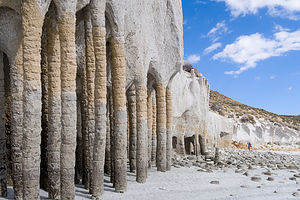 Crowley Lake Stone ColumnsWe were at a total loss as to how these strange pillar-like formations came to be, so of course we reached for our cell phones and googled it. Apparently, we weren’t the only ones stumped as to their creation, and it was only recently that a team of researchers from UC Berkeley came up with a theory.
Crowley Lake Stone ColumnsWe were at a total loss as to how these strange pillar-like formations came to be, so of course we reached for our cell phones and googled it. Apparently, we weren’t the only ones stumped as to their creation, and it was only recently that a team of researchers from UC Berkeley came up with a theory.
As I am not a geologist, I will try to summarize what we read in an article in the Los Angeles Times.
For eons, the columns were buried and hidden, but when the Crowley Lake Reservoir was created in 1941, its pounding waves began carving out the softer material at the base of the cliffs (made of volcanic pumice and ash), eventually exposing the columns.
Still, how did the columns get there in the first place??? I’ll try to give it a go:
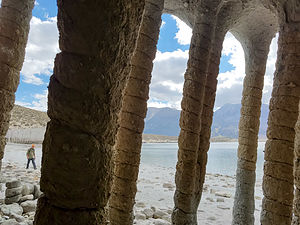 From inside the ColumnsThe whole Long Valley area is a large caldera formed hundreds of thousands of years ago after a violent volcanic explosion, which sent rivers of lava cascading over the surrounding desert which had just been covered by falling ash, instantaneously baking it to a layer of stone, known as tuff.
From inside the ColumnsThe whole Long Valley area is a large caldera formed hundreds of thousands of years ago after a violent volcanic explosion, which sent rivers of lava cascading over the surrounding desert which had just been covered by falling ash, instantaneously baking it to a layer of stone, known as tuff.
Now, this is where they really start to lose me.
The columns were created by snowmelt seeping down into, and steam rising up out of, the still hot tuff. The water boiled, creating “evenly spaced convection cells similar to heat pipes.” The tiny spaces in the convection pipes were cemented in place by erosion-resistant minerals.
Even if you don’t understand any of that, which I am not sure I do, they are really interesting and fun to look at.
We couldn’t leave the Long Valley without soaking in one of its beautiful natural hot springs, so we retraced our steps up the hill and back to the car and drove all the way back to one of our favorites, the Crab Cooker, a remote pool that we had discovered last year.
 Horizontals among the VerticalBecause it can only be reached by 4WDing over a rough road, it is much less visited than the more accessible Wild Willy’s, so hopefully we would find it empty. We also hoped we would find it hot, because it had not been on our last visit.
Horizontals among the VerticalBecause it can only be reached by 4WDing over a rough road, it is much less visited than the more accessible Wild Willy’s, so hopefully we would find it empty. We also hoped we would find it hot, because it had not been on our last visit.
Well, we did find it empty, which was great, but unfortunately it was a bit cool. However, Herb (my hero) found the valve between the hot water source and the pool and opened it, allowing steaming hot water to flow into the pool. While that was going on, we went back to the car to get our bathing suits and towels. By the time we returned, which couldn’t have been more than 5 minutes, the pool had gotten almost too hot, so Herb quickly closed the valve.
 Crab Cooker in Long ValleyThe air was a bit chilly, so the water felt divine, and the views of the surrounding mountains was pretty incredible. This pool was just too good to have to ourselves for long, so we were soon joined by three people, probably half our age. We spent the next half hour sharing stories of our various travels, and I would have to say that for their age, they had seen a lot.
Crab Cooker in Long ValleyThe air was a bit chilly, so the water felt divine, and the views of the surrounding mountains was pretty incredible. This pool was just too good to have to ourselves for long, so we were soon joined by three people, probably half our age. We spent the next half hour sharing stories of our various travels, and I would have to say that for their age, they had seen a lot.
What a full and wonderful day it had been - fishing, off-roading, hiking, a geological wonder, and a lovely hot spring to wrap it up.
- ‹ previous
- 2 of 3
- next ›
Mammoth Lakes location map in "high definition"
Javascript is required to view this map.
